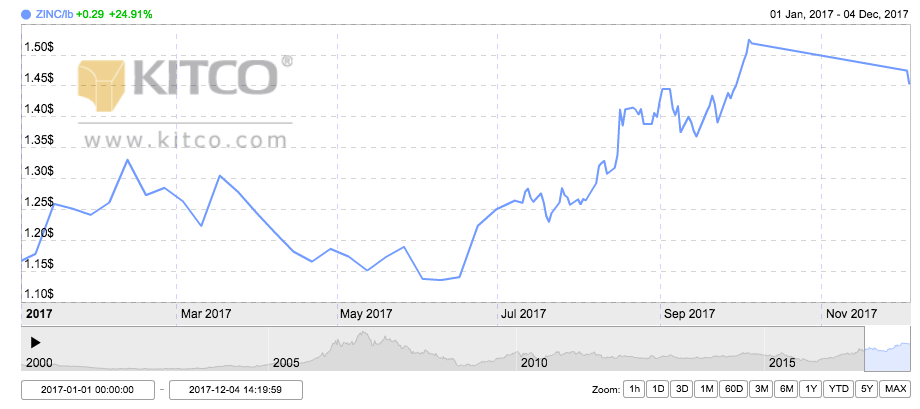Categories:
Base Metals
/
General Market Commentary
Topics:
General Base Metals
/
General Market Commentary
Zinc Outlook 2018: Will Prices Continue to Rally?
Zinc prices trended upward in 2017, and have now surged more than 21 percent year-to-date. Luckily for fans of the base metal, many analysts remain bullish for 2018.
Supply concerns have hit the refined zinc market in recent months, with prices reaching a decade high in August and continuing to trade above the $3,000-per-tonne level since then. As of Monday (December 11), LME zinc was changing hands at $3,092.
Read on to learn more what experts expect in terms of the zinc outlook next year, from supply and demand to potential price catalysts. All in all, the year looks set to be a good one.
Zinc outlook 2018: Price performance
In 2016, zinc was the best-performing LME metal, jumping more than 64 percent in 12 months. In 2017, zinc continued to climb, but at a slower pace; as mentioned, it’s gained over 21 percent since January.
As the chart below from Kitco shows, zinc’s highest point of the year came in October, when it hit a more than decade high of $3,369.50. Supply worries and a strong Chinese demand outlook supported the base metal’s rapid price rally.

Chart via Kitco.
The lowest point of the year for zinc came in June, when prices were trading at $2,435. A stronger US dollar and risk aversion due to geopolitical tensions turned investors away from the base metal.
One of the key zinc trends this year has been the depletion of zinc stocks built up over the past 10 years; they have run out due to mine closures and cutbacks.
According to CRU Group, that led to a deeper refined zinc metal deficit and to a drawdown in global stocks. “We correctly forecast physical market tightening, but the strong price reaction came sooner than we were expecting,” analysts at the firm said.
Similarly, CPM Group (HKEX:1932) commodity analyst Yvonne Li said that the tightness in the physical market was the main factor supporting significantly higher zinc prices this year. “[It] lasted longer than I had expected,” she added.
For his part, Junior Stock Review founder Brian Leni said that while he was expecting higher zinc prices in 2017, that didn’t translate into gains for the junior zinc stocks as he had estimated. “Companies with quality projects haven’t received much attention and, for the most part, have traded sideways in the second half of 2017,” he commented. Zinc CEOs have also identified this problem.
Zinc outlook 2018: Supply and demand dynamics
As mentioned, zinc prices have remained high in 2017, supported largely by supply-side factors.
According to the International Lead and Zinc Study Group, global refined zinc metal production is forecast to fall by 1.4 percent this year, to 13.53 million tonnes. However, next year the group predicts an increase of 3.9 percent, to 14.06 million tonnes.
That said, CRU Group analysts expect around 775,000 tonnes of new zinc mine supply to come onstream next year, with MMG’s (HKEX:1208) Dugald River mine and Vedanta’s (LSE:VED) Gamsberg mine being notable contributors to production.
Aside from those projects, Li expects East Siberian Metals’ Ozernoye field project and Mehdiabad mine to bring new production between 2018 and 2022. “These are expected to help significantly ease the tightness in the refined zinc market during the later years of the forecast period,” she said.
Despite those additions, CRU Group analysts believe global zinc stocks will continue to be rapidly drawn down in the first half of 2018, although this depletion will slow down in the second half of the year.
“Combined exchange zinc stocks at LME-registered and SHFE-registered warehouses could rise probably in the second half of 2018,” said Li, explaining that this will be a consequence of refined supplies rising and demand growth underperforming due to a slowdown in China’s economic growth.
“[That’s because] the government [will] rein in its debt problems while tackling pollution. However, because of the sheer size of the Chinese market, demand will increase but at a slower pace,” she added.
Similarly, CRU Group analysts expect Chinese zinc demand to grow next year, but at a slower rate. “High prices will also begin to constrain demand growth next year in China and elsewhere,” they added.
Outside of China, Li expects demand in the US and Europe to increase next year as industrial activities in both economies continue to gather pace.
With all that in mind, analysts forecast that the refined zinc market will remain in deficit in 2018. CRU Group estimates that the deficit will moderate from this year’s 750,000 tonnes to around 200,000 tonnes. Meanwhile, CPM Group expects the refined zinc market deficit to reach 400,000 tonnes in 2017, but come off to approximately 220,000 tonnes in 2018.